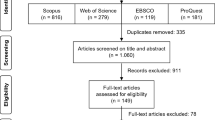Abstract
”Business intelligence” (BI) is a term for information systems which support decision makers in providing business analysis on the basis of internal and external data. Until now there exist only few valid results of research about the actual level of usage and maturity of implemented BI-systems. A maturity model with five levels of evolutionary development can be used as a framework for an empirical survey. Aspects like business content, technology and organisational impact are recorded and evaluated. First conclusions about the gap between theoretical concepts and the state of enterprise-wide implementations of BI systems are deduced. These statistical findings lead to a BI benchmarking in specific industrial sectors and general strategic recommendations.
Similar content being viewed by others
Literatur
Bauer, A.; Günzel, H. (Hrsg.): Data-Warehouse-Systeme. Heidelberg 2001.
Bollinger, T. B.; McGowan, C.: A Critical Look at Software Capability Evaluations. In: IEEE Software 8 (1991) 4, S. 25–41.
Brobst, S.: Enterprise Application Integration and Active Data Warehousing. In: von Maur, E.; Winter, R. (Hrsg.): Vom Data Warehouse zum Corporate Knowledge Center. Heidelberg 2002, S. 15-22.
Brunner, J.: Value-Based Performance Management: Wertsteigernde Unternehmensführung. Wiesbaden 1999.
Chamoni, P.; Gluchowski, P.: Analytische Informationssysteme — Einordnung und Überblick. In: Chamoni, P.; Gluchowski, P. (Hrsg.): Analytische Informationssysteme: Data Warehouse, On-Line Analytical Processing, Data Mining. 2. Auflage, Berlin u. a. 1999.
Codd, E. F.; Codd, S. B.; Salley, C. T.: Providing OLAP (On-Line Analytical Processing) to User-Analysts: An IT-Mandate. White Paper, o. O. 1993.
Devlin, B.: Data Warehouse: From Architecture to Implementation. Reading Mass. 1996.
Dittmar, C; Gluchowski, P.: Synergiepotenziale und Herausforderungen von Knowledge Management und Business Intelligence. In: Hannig, U. (Hrsg.): Knowlegde Management und Business Intelligence. Berlin u. a. 2002, S. 27–41.
Ehrenberg, D.; Heine, P.: Konzept zur Datenintegration für Management Support Systeme auf der Basis uniformer Datenstrukturen. In: WIRTSCHAFTSINFORMATIK 40 (1998) 6, S. 503–512.
Elmasri, R.; Navathe, S. B.: Grundlagen von Datenbanksystemen. 3. Auflage, München 2002.
Felden, C.: Analytische Informationssysteme im Energiehandel. In: Uhr, W; Esswein, W; Schoop, E. (Hrsg.): Wirtschaftsinformatik 2003, Band II, Medien — Mobile Märkte — Mobilität. Heidelberg 2003, S. 455–474.
Frank, U.: Wissenschaftliche Herausforderungen der Wirtschaftsinformatik. In: Ge-rum, E. (Hrsg.): Innovationen in der Betriebswirtschaftslehre. Wiesbaden 2002, S. 91–118.
Franken, R.; Gadatsch, A.: Integriertes Knowledge Management, Braunschweig, Wiesbaden 2002.
Gluchowski, P.; Gabriel, R.; Chamoni, P.: Management Support Systeme. Computergestützte Informationssysteme für Führungskräfte und Entscheidungsträger. Berlin u. a. 1997.
Gluchowski, P.: Business Intelligence -Konzepte, Technologien und Einsatzbereiche. In: HMD — Praxis der Wirtschaftsinformatik (2001) 222, S. 5–15.
Grothe, M.; Gentsch, P.: Business Intelligence. Aus Informationen Wettbewerbsvorteile gewinnen. München 2000.
Hackathorn, R. D.: Web Farming for the Data Warehouse. San Francisco 1998.
Inmon, W. H.: Building the Data Warehouse. 2. Auflage, New York 1996.
Jung, R.; Winter R.: Data Warehousing. Nutzungsaspekte, Referenzarchitektur und Vorgehensmodell. In: Jung, R.; Winter R. (Hrsg.): Data Warehousing Strategie. Berlin u. a. 2000, S. 3–20.
Kimball, R.: The Data-Warehouse Toolkit. New York 1996.
Krahl, D.; Windheuser, U.; Zick, F.: Data Mining. Einsatz in der Praxis. Bonn 1998.
Krcmar, H.: Informationsmanagement. 3. Auflage, Berlin 2002.
Mattison, R.: Data Warehousing: Strategies, Technologies and Techniques. New York 1996.
Meier, M.: Integration externer Daten in Planungs- und Kontrollsystemen — Ein Redaktions-Leitstand für Informationen aus dem Internet. Wiesbaden 2000.
Mellis, W.; Stelzer, D.: Das Rätsel des prozeßorientierten Softwarequalitätsmanage-ment. In: WIRTSCHAFTSINFORMATIK 41 (1999) 1, S. 31–39.
Mertens, P.; Griese, J.: Integrierte Informationsverarbeitung. Band 2, Planungs- und Kontrollsysteme in der Industrie. 9. Auflage, Wiesbaden 2002.
Mertens, P.: Business Intelligence — ein Überblick. Arbeitspapier Nr. 2/2002, Bereich Wirtschaftsinformatik I, Universität Erlangen-Nürnberg 2002.
Mummert Consulting AG: Business Intelligence Studie biMA 2004. Wie gut sind die BI-Lösungen der Unternehmen in Deutschland? BI-Benchmarking-Studie 2004, Hamburg 2004.
Neely, A.: Measuring Business Performance. London 1998.
Paulk, M. C; Weber, C. V.; Curtis, B.; Chrissis, M. B.: The Capability Maturity Model: Guidelines for Improving the Software Process. Reading, MA 1993.
Whitehorn, M.; Whitehorn M.: Business intelligence. The IBM solution. London 1999.
Author information
Authors and Affiliations
Corresponding author
Rights and permissions
About this article
Cite this article
Chamoni, P., Gluchowski, P. Integrationstrends bei Business-Intelligence-Systemen. Wirtschaftsinf 46, 119–128 (2004). https://doi.org/10.1007/BF03250931
Issue Date:
DOI: https://doi.org/10.1007/BF03250931




